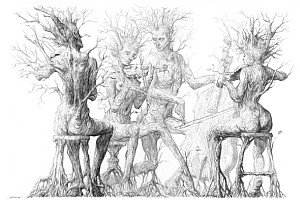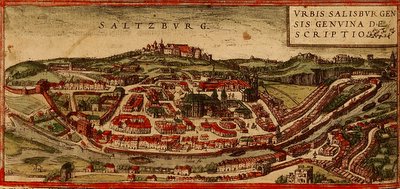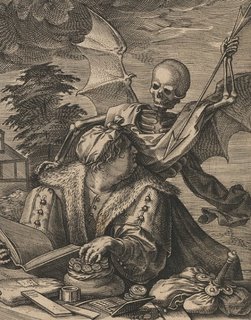





 La Science Amusante - 100 Nouvelles Experiences by Tom Tit (Arthur Good) with illustrations by Poyet was first published in the french magazine L'Illustration and later released in 3 sections between 1890 and 1893.
La Science Amusante - 100 Nouvelles Experiences by Tom Tit (Arthur Good) with illustrations by Poyet was first published in the french magazine L'Illustration and later released in 3 sections between 1890 and 1893.
It was obviously aimed at youngsters, outlining how they could go about astounding their friends with feats involving static electricity, shadow effects, water tension, vacuums, balancing and other simple scientific phenomena.
La Science Amusante is online at the FullTable website, which has a slow server.
Saturday, March 04, 2006
La Science Amusante
Friday, March 03, 2006
Settala's Wunderkammer
"...a goodly, huge cabinet, wherein whatsoever the hand of man by exquisite art or engine has made rare in stuff, form or motion; whatsoever singularity, chance, and the shuffle of things hath produced; whatsoever Nature has wrought in things that want life and may be kept; shall be sorted and included." [Bacon]









 [click the images for full size versions]
[click the images for full size versions]It's little wonder that the drama and embellishment of the baroque aesthetic gave rise to a 17th century enthusiasm for the wunderkammer or 'cabinets of curiosity' that would eventually beget our modern museums. I was a little surprised in reading around at just how popular they were across Europe. Increased world travel and trade brought a variety of oddities back to the monied elite who would display them in order to demonstrate a deeper understanding of their changing world.
One such famous collector was Manfredo Settala (1600-1680) of Milan who Filippo Picinelli described as "the Archimedes of our century". Settala was from a noble family and had an opportunity to travel abroad early in life when his fascination for collecting all manner of unusual naturalistic, ethnological and artistic specimens began. He was also interested in science and became proficient in metalwork and the instruments he crafted on a lathe were added to his collection; which also included a huge library.
During the 1660s a catalogue of his 3000-odd specimens was commissioned and artistic contributions to the inventory were made by Domenico Tencala, Francisco Porro, Giovanni Battista, Francisco Volpino, Alfonso Coast, Carolo a Sole and Carolo Galluzio. The images here are from the 3rd volume (the first 2 are housed in the library at Modena) and depict vases, clocks, animals, skulls, jewellery, crockery, precious stones and crystals and the instruments made by Settala himself. Some of these latter objects were modified with for instance magnets (eg. the fish in the image above would spin) so as to increase their novelty value.
I've only skimmed the wide selection of online sources and hope I've understood the translations correctly - as always, buyer beware. I've retouched most of the above images to try to remove the watermarks.
- [nb. this link now dead; see asterisk below]
The 195 page Codex Settala is displayed online by Milan's Biblioteca Ambrosiana - I liked the flash format. (html version - click 'Sfoglia') [translation of explanatory notes]* There are illustrations on every page accompanied by what I'm assuming is Settala's own handwriting describing each object - I haven't added these notes above because the translations were a bit strange. - Update* (2012) As Andrea kindly points out in the comments below, the two volumes of Settala's manuscript are available (as .pdf) via the Estense Library in Modena.
- Manfredo Settala at the Storia di Milano website (translation).
- The history of scientific collections at the Università di Pavia (translation).
- Mathematical Wunderkammern by William Mueller [2.8Mb pdf] {html version}
- Images of European wunderkammer at the Cabinets de Curiosités website.
- Misteraitch's interesting post about ivory objects fashioned by or after Settala.
Thursday, March 02, 2006
Middle Earth

"The view of Venice is that of 1565 by Bolognino Zaltieri (fl. 1560-80))—a feast for the eyes reflecting the wealth and architectural richness of the Serenissima. It references 188 buildings, bridges, and areas of the city by number, and it individually identifies many more of the canals, churches, and surrounding islands. Few have changed today. The image is a celebration of the city's political power as much as a spatial guide to its monuments and form. The wide variety of ships in the image underscores Venice's naval and economic dominance in the Adriatic. The political identity of the city is emphasized by the inclusion of a ceremonial procession of the Doge and members of the patriciate Senate of the city, here shown in formal dress, depicted in the center insert in the image's lower panel."
[Click the pictures for larger versions]
Civitates Orbis Terrarum ('Cities of the Earth') is a mammoth 5 volume publication of over 540 city maps (mainly in Europe), released to great popularity between 1572 and 1617. The principal editor was Georg Braun and among the 100 people involved in its production, Belgian Frans Hogenberg did most of the engraving work.
Jovis Hoefnagel (and later his son Jacob) provided the bulk of the birds-eye city drawings but there were many sources used. Abraham Ortelius, who produced the first world atlas, was both an inspiration and practical advisor for the Civitates Orbis Terrarum project. Indeed, Hogenburg had engraved most of the plates in Ortelius's groundbreaking 1570 Theatrum Orbis Terrarum.
Interestingly, Braun mentions in Volume 1 that the human figures seen in many of the maps were added not so much as a popularizing embellishment, but as a precaution to prevent the Turks from acquiring military secrets. Their religion forbade them from gazing on depictions of people...or so the story goes.
The maps in fact invite quite a depth of historical scholarship - there is a geospatial accuracy in relation to much of the architecture and city planning, fortifications as they actually existed are included, the costumes of the people are themselves source material and an overall sense of the economic and trade status of these urban centres can be inferred.
- The Israeli site, Historic Cities, have a large number of multiple resolution images from Civitates Orbis Terrarum online. I think I would want to check some other sources regarding background detail on general principles however. They have sourced their images from the Hebrew University of Jerusalem and the Jewish National & University Library.
- The Gun Powder, Compass and Printing Press Oxford University course material website have a small number of images available with zooming capability (some interesting things in that site).
- In Prayse of the Needle have some scans of costumes taken from English city maps (another interesting site to look around - historical inspired needlework)
 On a completely different note, if you haven't come across the Coudal Partners website before, go check it out, including their MoOM. Despite my making guest contributions there this month, it's a great site.
On a completely different note, if you haven't come across the Coudal Partners website before, go check it out, including their MoOM. Despite my making guest contributions there this month, it's a great site.UPDATE 2010: (essentially seems to be the same as above as far as I've looked) -- Braun, Georg; Hogenberg, Franz; Novellanus, Simon Beschreibung vnd Contrafactur der vornembster Stät der Welt (Band 1) at the University of Heidelberg.
Wednesday, March 01, 2006
Wrestling in 1500
 "In Saint George’s name commence, and show to the first, over the
"In Saint George’s name commence, and show to the first, over theopponent.High or low movements, this is how the wrestling begins."
 "When he holds himself completely erect and braces from behind, thus you have
"When he holds himself completely erect and braces from behind, thus you havehim in the Hacken (Leg Hook). So use this technique, that is called the Sthragft."
 "When he will pull your Hacken from his leg. Thus use this
"When he will pull your Hacken from his leg. Thus use thistechnique. It is called the Rigel (bar or barrier). "
 "Then he has lifted you completely and has made you come against your will. So use the technique that you see here.Thus he must let go of you or you break his arm."
"Then he has lifted you completely and has made you come against your will. So use the technique that you see here.Thus he must let go of you or you break his arm."This treatise from ~1505 by Hans Wurm is another in the large body of illustrated German combat manuals, the Fechtbücher. It continues a tradition of describing the kampfringen - a system of combat grappling or wrestling originating with the teachings of Ott Judd from ~the early 15th century.
- 23 woodcuts are included in the manual and they serve as a reminder of how bad block colouring can be. It is certainly a very early example of a wrestling manual but it is unlikely to have been the first. All the plates from Das Ringersbuch by Hans Wurm are displayed at the Association for Renaissance Martial Arts website. They have also included a translation and commentary.
- It's arguably easier to view the images at this photo-server because they have posted 3 different sizes. The large images at the ARMA site take a long time to load.
- Timeline of the Fechtbücher.
- Interestingly enough, there is a Catholic Academy of Sacramental Combat Arts website which attempts to project a religious dimension onto Wurm's book. (I mostly posted this link because of the website title. Easily amused? Sometimes.)
Tuesday, February 28, 2006
Ballet Sketch
Joseph Paget-Fredericks (1905-1963) inherited his parents love for collecting theatre memorabilia and studied art at the University of California and in Europe. His family had close ties to the elite ballet companies and he was appointed Artistic Director for Anna Pavlova's world tours in the early 1930s.
He went on to become the first lecturer in dance in the United States, taught colour and design and released several childrens books; and also a book about Pavlova from a planned series of ballet recollection pieces.
The online version of the Joseph Rous Paget-Fredericks Dance Collection, ca. 1913-1945 consists of 8 thumbnail pages (3 of photographs) of 368 images at UC Berkley's Bancroft Library. The material is either original drawings by Paget-Fredericks or material he collected. It would be fair to say that Anna Pavlova dominates the web collection, one way or another. Summary and biography.
"The categories by subject include: Isadora Duncan; Loie Fuller; Vaslav Nijinsky; Anna Pavlova; Ruth St. Denis; other dancers; decor and costume designs for ballets; other figure and costume studies; illustrations and graphic design; miscellaneous drawings and paintings; juvenilia; historic dance costumes; printed pictures and clippings; photographic prints; portraits; and works by other artists in various media."
Coins and Conscience
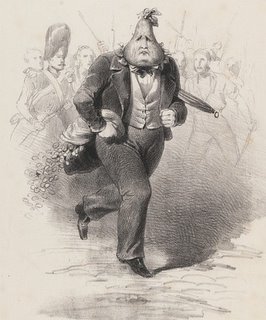 La Poire Tapée
La Poire TapéeLithograph by unknown artist ~1848
"A pear-headed [King] Louis-Philippe runs from an angry crowd while money falls out of abag he carries. The title is a play on words—it can mean a pear that has been dried in the oven, or it can refer to the slang meaning of "taper," to borrow money from someone."
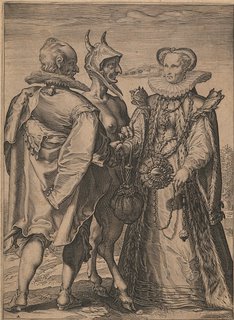 Marriage for Wealth Officiated by the Devil
Marriage for Wealth Officiated by the DevilEngraving by Jan Saenredam ~1600
"The second of three numbered engravings after Goltzius called the Marriage Trilogy. A devil joins the hands of a couple as she blows a stream of coins and smoke, symbolizing the transience of honor and material possessions."
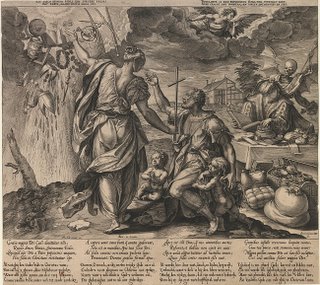 The Two Deaths
The Two DeathsLate 16th century engraving by Hieronymus Wierx after Marten de Vos
"A narrative in two parts. At left, a pious man receives riches from heaven; at right, Death prepares to strike a miser amidst his wealth."
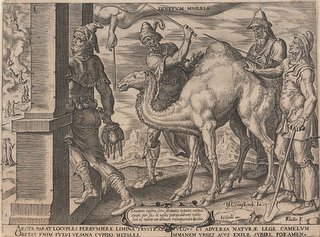 The Unhappy Lot of the Rich
The Unhappy Lot of the RichEngraving by Phillip Galle 1563
"Plate one of his series of six engravings after Heemskerck with this title, published in 1563. A later state, shown here, called Divitum Misera Sors, was issued by Joannes Galle. Illustration of Matthew 19:23-24. A rich man tries to enter the gate to Heaven, but his money bags hold him back. Behind him, three men try to lead a camel through the eye of a needle."
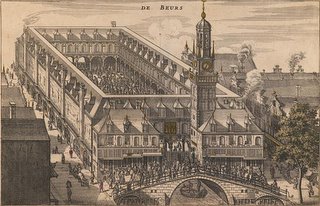 De Beurs Stock Exchange
De Beurs Stock ExchangeEarly 17th century engraving by unknown artist
"The Amsterdam exchange, situated on the Amstel River, was designed by Hendrick de Keijser and opened in 1611. Trading was carried on in the open inner court."
(still going)
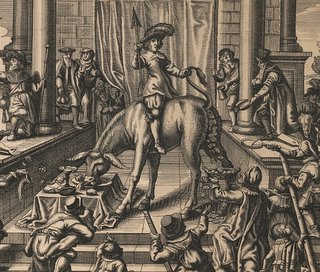 Der Bruder Esel mit dem Gelt [detail]
Der Bruder Esel mit dem Gelt [detail]"An ass is pictured defecating coins while peasants, merchants, and noblemen run to catch them."
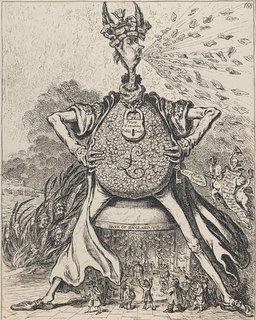 Midas, Transmuting all into Gold Paper
Midas, Transmuting all into Gold PaperEngraving by James Gillray 1797
"[S]atire on the creation of legal tender bank notes by the Bank of England. William Pitt is pictured spewing paper money out of his mouth, while gold coins are locked up in his stomach."
 Le Cornard Contant
Le Cornard ContantEarly 17th century engraving by CLD Ciatres
"Possibly a plate from his Oiseaux et Grotesques. The "happy cuckold" does not mind his lost honor, because his "horns of plenty" bring him immeasurable happiness. (French caption)."
Coins and Conscience - Popular Views of Money, Credit and Speculation is a presentation of 70 satirical, allegorical, religious, parodic and caricaturic prints (among some other faithfully rendered works) from the Bleichroeder Collection at Harvard Business School's Baker Library.
I think this is a brand new exhibition, which I found completely by accident, searching for a map of all things. There are high resolution images available and I know I've posted a couple of these prints before, including yesterday, but these Harvard files are of a very high quality. The exhibition includes an introductory essay.


